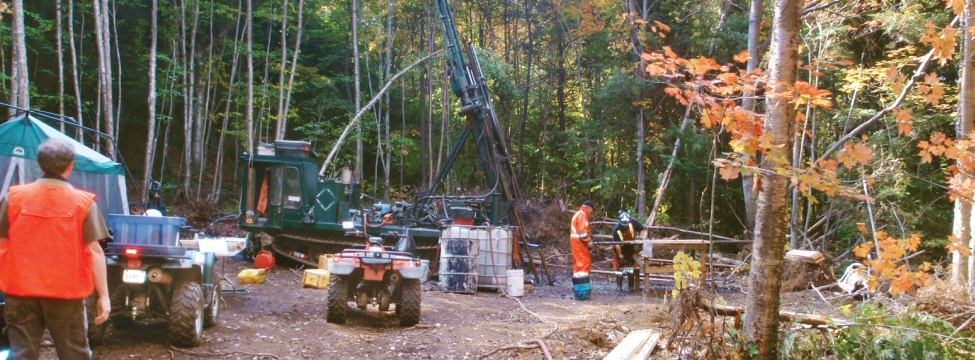To serve you better, our new website displays information specific to your location.
Please visit the site and bookmark it for future use.
Pele Mountain Resources at the Elliot Lake Project
Production of uranium in the Elliot Lake Camp began in 1955. An estimated 135,000 tons of uranium metal was produced from 12 mines by the end of 1989, at an average grade of approximately 0.09% U3O8. All of the mining took place underground and the primary mining method used was mechanized room and pillar.
The ore was hoisted and transported to a central mill for crushing and grinding, and was leached using sulphuric acid to dissolve the uranium. The uranium was then extracted from the solution using solvent extraction or ion exchange processes.
In addition to the primary production, small amounts of uranium were extracted from the mine water being pumped to the surface beginning in 1960. Denison Mines Corporation had maintained a limited underground bacterial leaching program since the mid-1960s and in 1980, initiated a research program to expand production from bacterial leaching. The underground leaching was carried out on lower grade ore blasted from the roof into the empty stopes, after the primary ore extraction was completed. The stopes were sealed with bulkheads and then flooded for leaching. Air was introduced into the stope to accelerate the leaching. Spray leaching was also tested to extract the uranium from a portion of the broken ore.
Pele Mountain Resources (PMR) began staking claims in the area in 2005, and in February 2008, commissioned SRK to prepare a preliminary mine layout that utilized the in-stope leaching method. SRK prepared 3D layouts for main ramps, sublevel access, mining panels and ventilation infrastructure. Drilling and blasting in the panels were designed to minimize the amount of reef material extracted and trucked to the surface, while maximizing the amount of uranium that could be recovered using the underground bacterial in-stope leaching program. The recovery of uranium in the production schedule was based on a time-recovery curve representing the leaching process.
SRK assisted PMR with the field exploration, reviewing the field data and drilling program, and developed a hydrogeologic and geotechnical program to collect data for future technical studies. SRK also assisted PMR with the submission of the Project Description to the regulatory authority.
Terry Mandziak: tmandziak@srk.com
Ken Reipas: kreipas@srk.com
The ore was hoisted and transported to a central mill for crushing and grinding, and was leached using sulphuric acid to dissolve the uranium. The uranium was then extracted from the solution using solvent extraction or ion exchange processes.
In addition to the primary production, small amounts of uranium were extracted from the mine water being pumped to the surface beginning in 1960. Denison Mines Corporation had maintained a limited underground bacterial leaching program since the mid-1960s and in 1980, initiated a research program to expand production from bacterial leaching. The underground leaching was carried out on lower grade ore blasted from the roof into the empty stopes, after the primary ore extraction was completed. The stopes were sealed with bulkheads and then flooded for leaching. Air was introduced into the stope to accelerate the leaching. Spray leaching was also tested to extract the uranium from a portion of the broken ore.
Pele Mountain Resources (PMR) began staking claims in the area in 2005, and in February 2008, commissioned SRK to prepare a preliminary mine layout that utilized the in-stope leaching method. SRK prepared 3D layouts for main ramps, sublevel access, mining panels and ventilation infrastructure. Drilling and blasting in the panels were designed to minimize the amount of reef material extracted and trucked to the surface, while maximizing the amount of uranium that could be recovered using the underground bacterial in-stope leaching program. The recovery of uranium in the production schedule was based on a time-recovery curve representing the leaching process.
SRK assisted PMR with the field exploration, reviewing the field data and drilling program, and developed a hydrogeologic and geotechnical program to collect data for future technical studies. SRK also assisted PMR with the submission of the Project Description to the regulatory authority.
Terry Mandziak: tmandziak@srk.com
Ken Reipas: kreipas@srk.com
|
You can download a PDF of the entire |
PDF A4
|
PDF Letter
|
|
|
|
Our newsletters focus on specific areas of interest to earth resource professionals and clients. Each is available as an Adobe Acrobat PDF file. If you don't already have Adobe's PDF reader, you can download it free.


